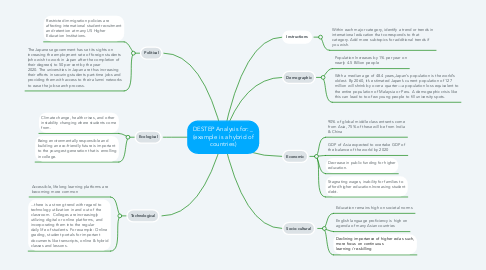DESTEP Analysis for: ___ (example is a hybrid of countries)
by Daniel Chatham

1. Technological
1.1. Accessible, lifelong learning platforms are becoming more common
1.2. ...there is a strong trend with regard to technology utilization in and out of the classroom. Colleges are increasingly utilizing digital or online platforms, and incorporating them into the regular daily life of students. For example: Online grading, student portals for important documents like transcripts, online & hybrid classes and lessons.
2. Ecological
2.1. Climate change, health crises, and other instability changing where students come from.
2.2. Being environmentally responsible and building an eco-friendly future is important to the youngest generation that is enrolling in college.
3. Political
3.1. Restricted immigration policies are affecting international student recruitment and retention at many US Higher Education Institutions.
3.2. The Japanese government has set its sights on increasing the employment rate of foreign students (who wish to work in Japan after the completion of their degrees) to 50 per cent by the year 2020. The universities in Japan are thus increasing their efforts in securing students part-time jobs and providing them with access to their alumni networks to ease the job search process.
4. Instructions
4.1. Within each major category, identify a trend or trends in international education that corresponds to that category. Add more subtopics for additional trends if you wish.
5. Demographic
5.1. Population Increases by 1% per year on nearly 4.5 Billion people
5.2. With a median age of 48.4 years,Japan’s population is the world’s oldest. By 2060, it’s estimated Japan’s current population of 127 million will shrink by over a quarter—a population loss equivalent to the entire population of Malaysia or Peru. A demographic crisis like this can lead to too few young people to fill university spots.
6. Economic
6.1. 90% of global middle class entrants come from Asia, 75% of these will be from India & China
6.2. GDP of Asia expected to overtake GDP of the balance of the world by 2020
6.3. Decrease in public funding for higher education.
6.4. Stagnating wages, inability for families to afford higher education.Increasing student debt.
7. Socio-cultural
7.1. Education remains high on societal norms
7.2. English language proficiency is high on agenda of many Asian countries
7.3. Declining importance of higher ed as such, more focus on continuous learning / re-skilling


